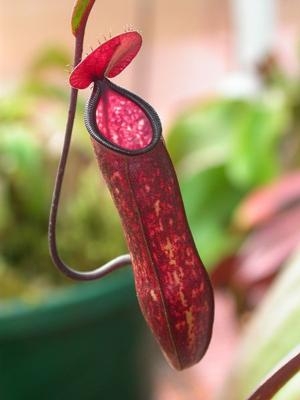Sun, Jan 05, 2014
Substance Could Prevent Ice From Adhering To Surfaces During Flight
A tropical carnivorous plant – the pitcher plant – which traps its prey inside its body with a virtually frictionless surface is inspiring a new generation of coatings capable of repelling liquids including blood, oil, honey and even ice on aircraft.

Nature is well-known for its ability to repel liquids with lotus leaves, rice leaves, butterfly wings, mosquito compound eyes, cicada wings, red rose petals, gecko feet, desert beetles, and spider silk all having the ability to remain dry. However, the pitcher plant or Nepenthes, which is found in countries including Australia, Malaysia and Madagascar, has a special adaptation which creates a near frictionless surface with unique self-healing properties.
The ability to repel liquids and contaminants has important applications to industry and everyday life. Coatings are needed to help stop the formation of life-threatening bacteria on medical instruments, ice build-up on aircraft, fouling on ship hulls, anti-corrosion and the efficient transportation of products like crude oil by pipeline.
The pitcher plant is different to some other nature-inspired adaptations by ‘locking-in’ a lubricant layer onto the surface of its skin which cannot be penetrated by another liquid and is more damage tolerant. The result is also fatal to the plant’s prey – insects and small frogs – which are unable to climb out of its smooth, deep, tubular-shaped body. A team at Harvard University have now been able to mimic the pitcher plant’s inner skin design to produce a transparent coating capable of being economically applied to almost any object – large or small.
The multi-stage coating process involves attaching a thin, but rough layer of porous silica particles which are used to lock-in a lubricating layer onto the surface to be protected. Its diverse applications could include acting as an anti-graffiti coating on walls or on medical implants to aid blood flow.
This latest development in coating technology reached the finals of this year’s Institution of Chemical Engineers (IChemE) Awards in the UK, which recognizes excellence and innovation in the chemical and process industries worldwide. “Some existing coatings have limitations including contamination and degradation by contaminants, lack of self-healing capabilities and damage tolerance," said IChemE’s chief executive, Dr David Brown. “By mimicking the pitcher plants skin structure, Harvard University’s new coating self-heals almost instantly, even if scraped with a knife or blade. It is capable of operating in extreme temperatures and high pressure, and can be applied to surfaces ranging from metals and semiconductors, to paper and cotton fabric.
“It is a very clever solution by the team at Harvard University and another excellent example of how chemical engineering is being used to improve the features and performance of products we need and rely upon every day.”
(Public domain image via Wikipedia)
More News
Also: ANOTHER Illegal Drone, KidVenture Educational Activities, Record Launches, TSA v Shoes The Senate confirmed Bryan Bedford to become the next Administrator of the FAA, in a ne>[...]
Also: Sully v Bedford, Embraer Scholarships, NORAD Intercepts 11, GAMA Thankful Middle Georgia State University will be joining the Federal Aviation Administration’s fight ag>[...]
Also: DarkAero Update, Electric Aircraft Symposium, Updated Instructor Guide, OSH Homebuilts Celebrate The long-awaited Sonex High Wing prototype has flown... the Sonex gang tells >[...]
Also: Sully v Bedford, Embraer Scholarships, NORAD Intercepts 11, GAMA Thankful Middle Georgia State University will be joining the Federal Aviation Administration’s fight ag>[...]
30-Year USCG Veteran Aviator Focusing On Member Benefits The Vertical Aviation International Board of Directors announced its new leadership officers in April, and all began their >[...]
 Airborne 07.11.25: New FAA Boss, New NASA Boss (Kinda), WB57s Over TX
Airborne 07.11.25: New FAA Boss, New NASA Boss (Kinda), WB57s Over TX Airborne-Flight Training 07.10.25: ATC School, Air Race Classic, Samson School
Airborne-Flight Training 07.10.25: ATC School, Air Race Classic, Samson School Airborne Affordable Flyers 07.03.25: Sonex HW, BlackShape Gabriel, PRA Fly-In 25
Airborne Affordable Flyers 07.03.25: Sonex HW, BlackShape Gabriel, PRA Fly-In 25 Airborne-Flight Training 07.10.25: ATC School, Air Race Classic, Samson School
Airborne-Flight Training 07.10.25: ATC School, Air Race Classic, Samson School Rick Kenin New Board Chair of VAI
Rick Kenin New Board Chair of VAI



